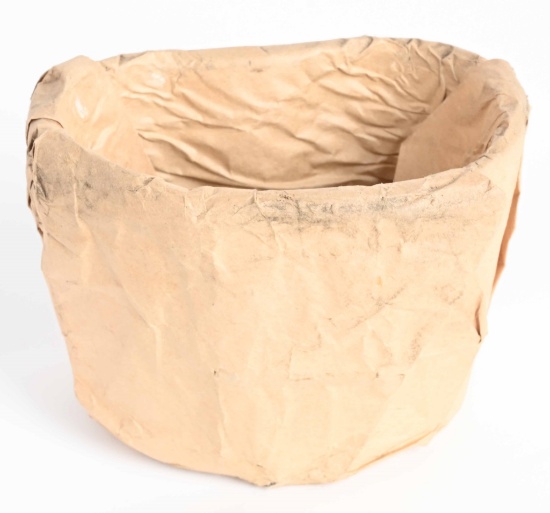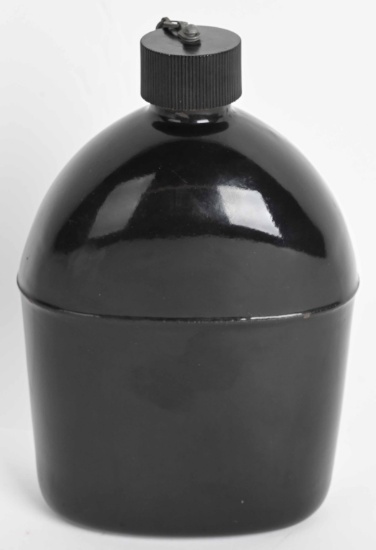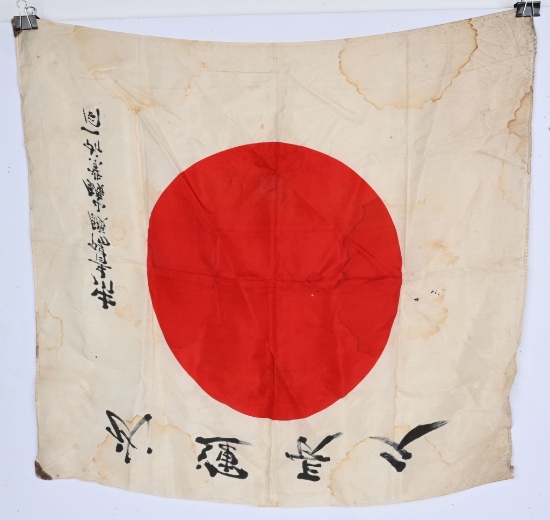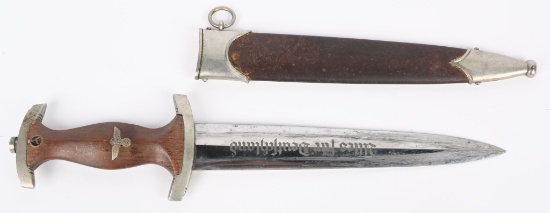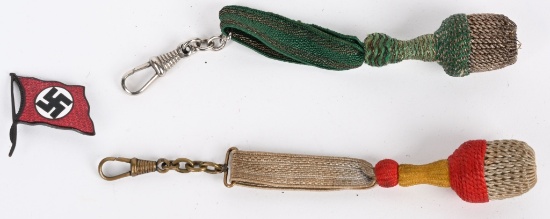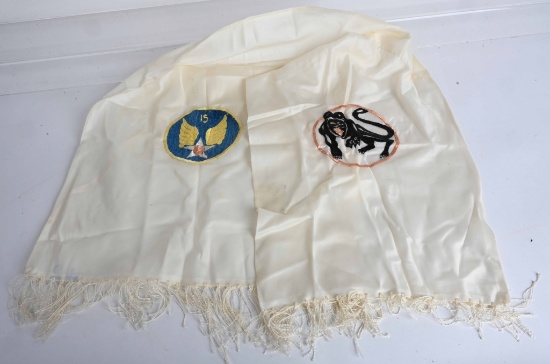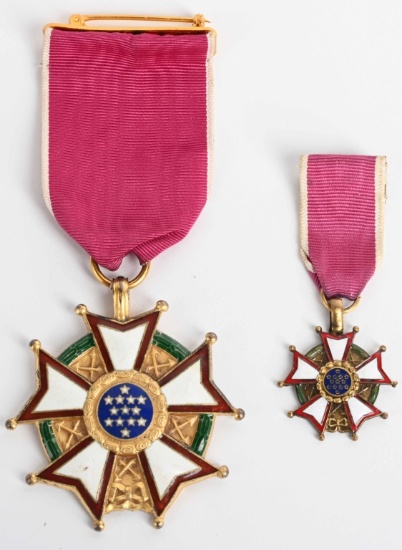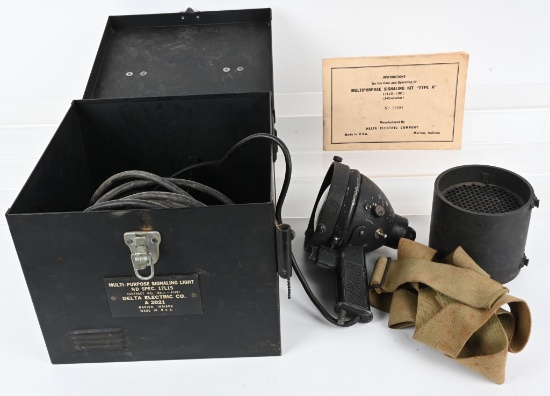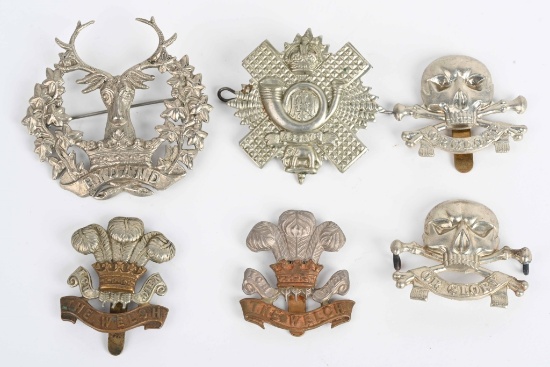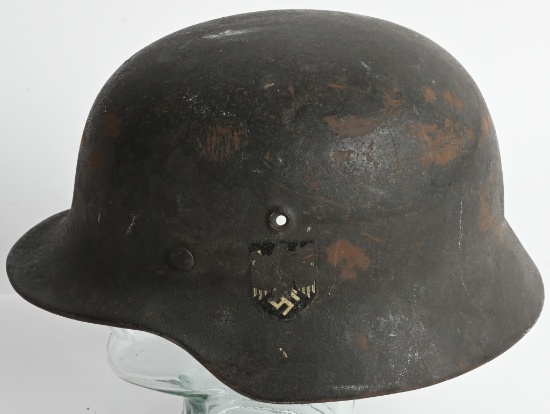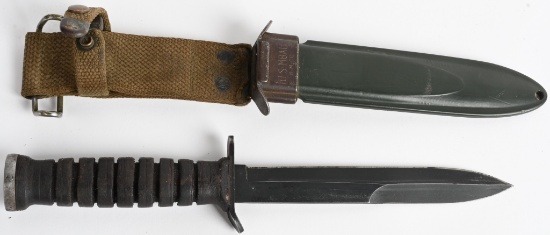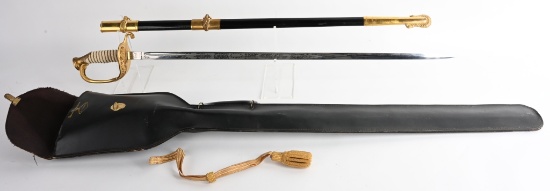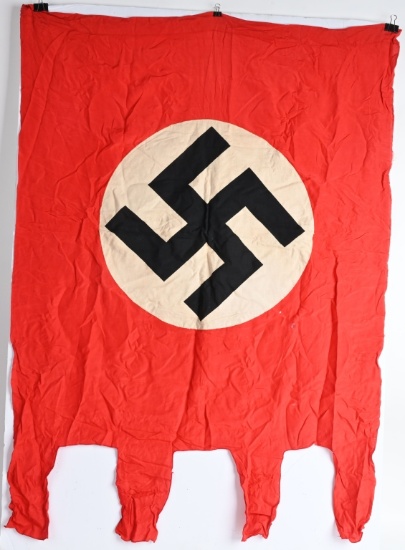Lot # 390 (Sale Order: 406 of 874)
Low Estimate: 800High Estimate: 1,000
Early, (Circa 1933-1934), nice quality dagger features a roughly, 8 3/4", (22.3 cm), long, double edged, nickel/silver plated, drop forged steel construction blade with a low central ridge and a full length, including the hilt, of roughly, 13 5/8", (34.7 cm). The nickel/silver plated blade shows light to moderate scabbard runners and some minor spotting with some of the original cross graining still being visible. The obverse of the blade has the nice, deep, well defined, acid etched Fraktur style, script motto, "Alles für Deutschland", (All/Everything for Germany), which is crisp and well defined. The reverse of the blade has the acid etched, manufacturer’s name/logo, of Carl Schmidt Sohn A. G. of Solingen. The dagger has the early, cast, solid, nickel/silver crossguard, pommel, and tang nut which all show a nice, even, light, age patina. The reverse of the crossguard is stamped with the SA-Gruppe abbreviation, "S". The dagger has a very nicely contoured hardwood grip with reddish accents, which has a nice snug fit to both the top and bottom fittings. The grip has a nicely inset, nickel/silver plated, alloy national eagle and a nickel/silver plated and enameled runic SA button both intact. The dagger comes with it’s original, coppery brown, anodized, magnetic sheet metal scabbard with solid nickel/silver fittings and retains about 70% of its original coppery brown anodized finish. The top fitting has the presentation "Gew. d. Kameraden d. Sturmes N/94 8.9.35". The scabbard fittings have the same nice, even, light, age patina as found on the crossguard, pommel, and tang nut. Both of the scabbard fittings retain their original, dome headed, securing screws and the top fitting also retains its hanger suspension loop and ring. Nice, early, example by a seldom encountered manufacturer. Excellent The SA, Sturm Abteilung, (Storm/Assault Detachment), was originally formed in the August 1921 as a protective guard unit for the political leaders of the fledgling NSDAP, Nationalsozialistische Deutsche Arbeiterpartei, (National Socialist German Worker’s Party), and as with the NSDAP the SA was structure along para-military lines. The SA recruited most of its personnel from the ranks of the various Freikorps, (Free Corps), groups composed mainly of disgruntled, ex-WWI soldiers and was first utilized at a NSDAP meeting in Munich in November 1921.The SA M33 service dagger was the first dagger officially sanctioned by the NSDAP and was introduced on December 15TH 1933. The dagger was intended as an ornamental item and the design was adapted by Professor Woenne of the Solingen School of Commerce who had based it on the traditional 16TH century, Swiss "Holbein", "Baselard" or "Basilard", hunting dagger with the original design being attributed to the Hans Holbein the Younger, (Circa 1497-1543). Originally the daggers featured an anodized scabbard and utilized nice quality, solid, nickel/silver fittings while later models had cheaper, nickel/silver plated fittings and painted scabbards. Regulations dictated that the daggers were to worn on the left side of the waist belt suspended by a specific, dagger hanger. In late 1934 items manufactured for the SA including daggers and accoutrements came under the quality control of the RZM, Reichzeugmeisterei, (National Equipment Quartermaster) and as a result were marked with the RZM logo when appropriate. Of Note: The RZM was official founded in June 1934 in Munich by the NSDAP as a Reich Hauptamt, (State Central Office), and was based on the earlier SA Quartermaster’s Department. The functions of the RZM were not only to procure and distribute items to Party formations, but also to approve chosen designs and to act as a quality control supervisor to ensure items manufactured for the Party met required specification and were standardized. Production of the SA M33 dagger was discontinued sometime in 1943. Of Note: Other daggers initiated by the SA included the Marine-SA Dagger, circa 1933-34, originally with black grip and scabbard and later with brown grip and scabbard but with brass colored fittings, the short lived, (Circa February 3RD 1934-July 4TH 1934), SA-Stabschef, (SA-Chief of Staff), Ernst Röhm Dedication Dagger with the inscription, "In herzlicher Freundschaft Ernst Röhm", (In heartfelt Friendship Ernst Röhm). After Röhm’s demise the new SA-Stabschef, Viktor Lutze introduced the SA Honour Dagger, circa 1935, the SA Standarte Feldhernnhalle Dagger, circa 1937, the SA High Leader’s Honour Dagger, circa 1938 and the Special SA Presentation Dagger circa 1938-39.
Early, (Circa 1933-1934), nice quality dagger features a roughly, 8 3/4", (22.3 cm), long, double edged, nickel/silver plated, drop forged steel construction blade with a
...more low central ridge and a full length, including the hilt, of roughly, 13 5/8", (34.7 cm). The nickel/silver plated blade shows light to moderate scabbard runners and some minor spotting with some of the original cross graining still being visible. The obverse of the blade has the nice, deep, well defined, acid etched Fraktur style, script motto, "Alles für Deutschland", (All/Everything for Germany), which is crisp and well defined. The reverse of the blade has the acid etched, manufacturer’s name/logo, of Carl Schmidt Sohn A. G. of Solingen. The dagger has the early, cast, solid, nickel/silver crossguard, pommel, and tang nut which all show a nice, even, light, age patina. The reverse of the crossguard is stamped with the SA-Gruppe abbreviation, "S". The dagger has a very nicely contoured hardwood grip with reddish accents, which has a nice snug fit to both the top and bottom fittings. The grip has a nicely inset, nickel/silver plated, alloy national eagle and a nickel/silver plated and enameled runic SA button both intact. The dagger comes with it’s original, coppery brown, anodized, magnetic sheet metal scabbard with solid nickel/silver fittings and retains about 70% of its original coppery brown anodized finish. The top fitting has the presentation "Gew. d. Kameraden d. Sturmes N/94 8.9.35". The scabbard fittings have the same nice, even, light, age patina as found on the crossguard, pommel, and tang nut. Both of the scabbard fittings retain their original, dome headed, securing screws and the top fitting also retains its hanger suspension loop and ring. Nice, early, example by a seldom encountered manufacturer. Excellent The SA, Sturm Abteilung, (Storm/Assault Detachment), was originally formed in the August 1921 as a protective guard unit for the political leaders of the fledgling NSDAP, Nationalsozialistische Deutsche Arbeiterpartei, (National Socialist German Worker’s Party), and as with the NSDAP the SA was structure along para-military lines. The SA recruited most of its personnel from the ranks of the various Freikorps, (Free Corps), groups composed mainly of disgruntled, ex-WWI soldiers and was first utilized at a NSDAP meeting in Munich in November 1921.The SA M33 service dagger was the first dagger officially sanctioned by the NSDAP and was introduced on December 15TH 1933. The dagger was intended as an ornamental item and the design was adapted by Professor Woenne of the Solingen School of Commerce who had based it on the traditional 16TH century, Swiss "Holbein", "Baselard" or "Basilard", hunting dagger with the original design being attributed to the Hans Holbein the Younger, (Circa 1497-1543). Originally the daggers featured an anodized scabbard and utilized nice quality, solid, nickel/silver fittings while later models had cheaper, nickel/silver plated fittings and painted scabbards. Regulations dictated that the daggers were to worn on the left side of the waist belt suspended by a specific, dagger hanger. In late 1934 items manufactured for the SA including daggers and accoutrements came under the quality control of the RZM, Reichzeugmeisterei, (National Equipment Quartermaster) and as a result were marked with the RZM logo when appropriate. Of Note: The RZM was official founded in June 1934 in Munich by the NSDAP as a Reich Hauptamt, (State Central Office), and was based on the earlier SA Quartermaster’s Department. The functions of the RZM were not only to procure and distribute items to Party formations, but also to approve chosen designs and to act as a quality control supervisor to ensure items manufactured for the Party met required specification and were standardized. Production of the SA M33 dagger was discontinued sometime in 1943. Of Note: Other daggers initiated by the SA included the Marine-SA Dagger, circa 1933-34, originally with black grip and scabbard and later with brown grip and scabbard but with brass colored fittings, the short lived, (Circa February 3RD 1934-July 4TH 1934), SA-Stabschef, (SA-Chief of Staff), Ernst Röhm Dedication Dagger with the inscription, "In herzlicher Freundschaft Ernst Röhm", (In heartfelt Friendship Ernst Röhm). After Röhm’s demise the new SA-Stabschef, Viktor Lutze introduced the SA Honour Dagger, circa 1935, the SA Standarte Feldhernnhalle Dagger, circa 1937, the SA High Leader’s Honour Dagger, circa 1938 and the Special SA Presentation Dagger circa 1938-39.less...



 x Cancel
x Cancel